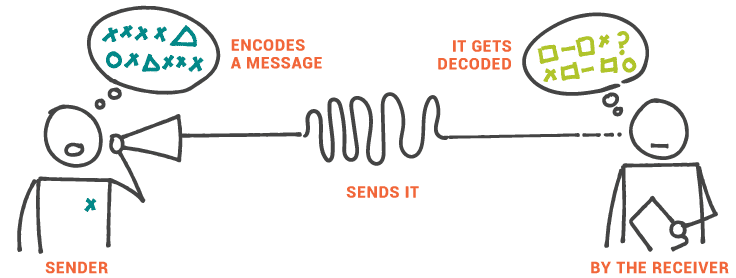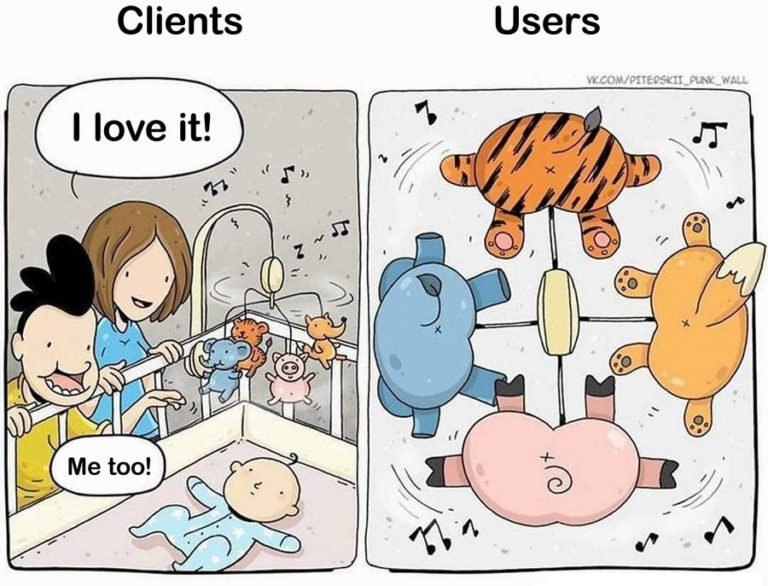
Why Are Prospects Not Understanding How Awesome You Are?
Do you feel like your prospects just don't get you?
Do they not see the value your company provides, no matter how many times you say it?
If they did, they would be beating down your door to hire you – but they aren’t.
Is your message wrong?
Don’t worry. You're not alone.
This is a problem every business has to deal with – not just in the commercial construction industry, but in every industry around the world.
Communicating what you do and why it matters to prospects—in a way that matters to them—should be simple.
So why is it difficult to actually do?
It seems so clear when we say it. We get it. We think everyone should get it, but often our message isn’t being heard the way we intend by our audience.
We can blame it on miscommunication, or timing, or maybe even the marketing channel. But before you go trying a new channel or sales tactic, let's stop and take a look at the actual problem that lies beneath the surface.
Let's break this down a bit.
Strip back everything – forget the fancy buzzwords, value propositions, the brand promises, the prices – let's go back to the basics of communication.
In its most basic form, the process of communication is a code.

That’s it.
Seems simple right? Well let’s add a bit of detail and you can see the complexity of the code.
- Sender – you, your company, your ads, your sales team, your staff
- Encodes a message – Wraps core value or offer in words, images or both
- Sends it – Via some channel: email, voice mail, snail mail, ad, video, post, blog, article, website, in-person…
- It gets decoded – Interpreted based on current mood, understanding of the subject and past experiences
- By the Receiver – The audience you want to become a customer, vendor, ally, partner…
Communication
We’ve been communicating in one form or another since we were babies, and more than likely you’ve gotten your point across more times than you haven’t. So, I’m going to assume it’s safe to say you are pretty good at communicating by now. You know how to say what you mean, mean what you say and your point of view is understood every single time, right?
No? Ok, that confirms, you are human.
Even though we’ve been communicating verbally and non-verbally all our lives, we all have plenty of examples of communication gone wrong. Misunderstandings with our parents, kids, significant others, co-workers, bosses, even with waitstaff – the list is never-ending. It’s easy to see in our personal and day-to-day lives but when it comes to marketing we think we’ve got it right. Our message is so obvious and clear.
But is that really true?
Missed Communication
There are so many ways for the communication process to go wrong. Mostly it has to do with a combination of the curse-of-knowledge and perspective-taking (or lack thereof). This can be broken down into four main categories:
- Right message, wrong audience
- Right audience, wrong message
- Right message, wrong channel
- Right channel, wrong message
Right message, wrong audience.
Most of the time the wrong audience isn’t as blatant as trying to sell new HVAC systems to college apartment dwellers or BMWs to elementary students. It’s more subtly wrong by trying to reach too broad of a market. It’s often referred to as “trying to be everything to everyone”.
Even Walmart and Target with their marketing budgets don’t market to everyone… so why would you?
“Our target is males and females, 18-65 who live in the United States”
“Female business owners”
“Millennial software users”
Marketing takes effort, time and money. How much depends on many factors, but it can be boiled down to how aligned your message is with the audience it is intended for.
The broader your audience and/or message, the more money it is going to take to get their attention.
Here is an example we can all relate to:
Walmart and Target sell basically the same stuff, just different quality (real or perceived) and at different price levels. Either company could say, “everyone is our customer let’s market to the WORLD”. But they don’t because they understand that not everyone loves them.
Walmart’s people care about “always low prices” and Target’s people care about the latest styles and trends at low prices, “Pay less, expect more”.
Their audiences are similar but at the same time, not at all similar. You probably identify as a Walmart or Target shopper. Each of these businesses is worth over $3.5 billion dollars and have obscene marketing budgets… and even they don’t market to everyone, so why the hell are you?
Finding the right message for the right audience
Hitting the sweet spot = loyal customers who want to pay for what you have
A client of ours sells specialty flooring maintenance programs to businesses.
They had a great company that offered a fantastic service and their customers loved them but prospects couldn’t find them, and if they did, the website was a big turn off and credibility killer. It was a melting pot of ideas that did not do the basic job of conveying what they did, for whom and why it mattered.
This problem is often hard to see from the inside of the business.
Prospects would often get my client’s business confused with nightly janitorial services. Because the site content was trying to be everything to everyone and therefore was watered down to please everyone, which means it appealed to no one.
There was a huge disconnect between who they are in real life and what they were projecting online, “we are for any business with a floor”.
Through the research and strategy phase of their rebrand, we discovered their sweet-spot prospect. Facility managers of image-conscious businesses but specifically, corporate campuses.
If the business only kinda cared about their floor, they were not going to be willing to pay for the deep level of specialty care my client provided on a monthly or quarterly basis.
Companies who are image-conscious understand the importance of maintaining their flooring assets as well as maintaining a high level of clean to honor and retain the best employees and clients.
We developed a deep profile on facility managers, the jobs they do, their goals, their struggles, what they care about most and who their customers are. That gave us the ability to write spot-on messaging that resonated with FMs. They started to hear, “wow you really get me”.
Since laser-focusing in on image-conscious corporate campuses and the facility managers in charge of these buildings, this client has seen the business boom and their already-impressive portfolio expand to include ongoing contracts with big players in their niche.

Image Credit: Serzhik Pitersky https://vk.com/piterskii_punk_wall
Right audience, wrong message
Let’s say you have the audience dialed in just right, but you are advertising features they don’t care about, or they just don’t care enough about it to make a change? This happens all the time.
The curse of knowledge often plays a role here. Research and perspective can really help. So can interviewing customers, talking with your front-line sales staff and customer service reps.
Let’s look at a glaring example of right audience, wrong message with Pepsi’s early 2000s faux pas in China, with their “Pepsi brings you back to life” campaign.
What the brand didn’t realize is that the phrase they used actually translated to “Pepsi brings your ancestors back from the grave.” Whoops.
When was the last time you actively aligned the value you create with your customers and your brand messaging? Over time, misalignment between the three leads to missed communication.
Wrong message is where the curse of knowledge can really hurt you.
In order to connect with your audience, you need to understand things from their point of view. Getting to know what their struggles and frustrations are, and dig into what they are really trying to accomplish. Get to know what they like, what they don’t like and most importantly – how they talk. This will help you understand what they care about.

There’s no point in telling your audience to yeet* their problems out of the way and enjoy the weekend if you’re talking to middle-aged accountants during tax season.
*If you’re not ‘down with the kids’, yeet means to throw something away in a hilarious, care-free way – yeah we had to look it up too.
Right message, wrong channel
A channel is a platform where your encoded message is passed onto the receiver. This includes face-to-face communication, websites, adverts, radio, television, e-mails, etc.
If you’re pushing your message to a millennial audience, you’re probably going to get a much better response on social media channels than traditional radio or newspaper ads.
If you miss the mark with the medium you choose, the audience who receives your message is going to be the wrong audience and won’t invest in your services.
Avoiding this mishap comes down to (yet again) research and sometimes a bit of trial and error. You want to figure out where your audience is hanging out, what they listen to, what they read and where they choose to communicate.
Right channel, wrong message
OK, you’ve figured out where your prospects hang out, what they enjoy engaging with and what they’re looking for, great. You put your message out there… and nothing. Well, nothing is a better response than all hell breaking loose!
Just look at the McDonalds campaign that highlighted some of their most famous billboards from the last 20 years. Sounds great, right? Evoking nostalgia is a great way to sell to customers!
The only problem was, McDonald’s showcase of their ‘greatest hits’ for the campaign focused heavily on 9/11.
The company got accused of trying to cash in on a national tragedy and they pulled the billboard campaign within a few days of launching.
Sending the wrong message to a prospect can be disheartening at best (nobody likes to be ignored) and business damaging at worst (hello Ronald).
Avoiding this one requires perspective-taking, research, and listening to feedback.
The moral of the story? Do your damn research!
To avoid communication breakdowns (or misfires), make sure you know your audience. Make sure you know your offerings.
You can’t be everything to everyone.
If you try to be everything to everyone, you end up meaning nothing to no one. A message that tries to speak to an undefined audience will fall on deaf ears and waste a ton of cash.
The same premise goes for a company that tries to offer every service possible – yet doesn’t do any of them particularly well (jack of all trades, master of none has never been more true). This always reminds me of the old 4-in-1 printers back in the day. Yes, you have one piece of equipment that does a ton of things, printer, scanner, copier, and fax, but it does all of them half-assed. Not a win in my book.
We’ve written about this problem before – a company needs to specialize or at least focus and needs to feel comfortable with what they do to be able to connect with their audience. If you’re not sure about what you do, how are potential customers going to know what you’re about?
Luckily for you, you’re in the right place.
Just fixing up the facade is not going to help a prospect figure out if you are the one for them.
Stop making clients work so damned hard to figure out if your solution is a fit to their problem, and let's go beyond the surface – together.
Our outside perspective will help define and align your product, audience, and message. We'll get to the core of who you are as a company, who your clients are and what they really want.
We rethink and rebrand businesses, and if this post resonates with you, it might be time for you to consider getting on a call with us to see what we can do for you.
Here are a few other articles you might like:
Tracy O’Shaughnessy Founder / Lead Brand Strategist of Branding & Beyond
Tracy and her team help firms in and around the B2B building trades look and sound credible online and off.
She has been in the industry since the early '90s and is tired of seeing fantastic firms struggle, blend in, and get bypassed by prospects who judge them solely on the outdated information found online.
Branding & Beyond's mission is to solve real business problems and build the brand foundation clients need to get noticed and hired.
You can find Tracy on Linkedin and here on this blog.
